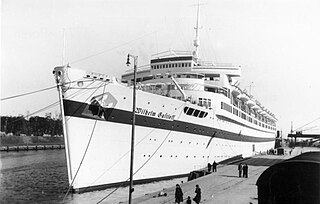
MV Wilhelm Gustloff was a German military transport ship which was sunk on 30 January 1945 by Soviet submarine S-13 in the Baltic Sea while evacuating civilians and military personnel from East Prussia and the German-occupied Baltic states, and German military personnel from Gotenhafen (Gdynia) as the Red Army advanced. By one estimate, 9,400 people died, making it the largest loss of life in a single ship sinking in history.
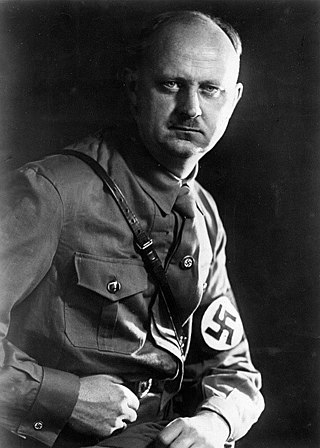
Wilhelm Gustloff was the founder of the Swiss NSDAP/AO at Davos. He led it from 1932 until his death.
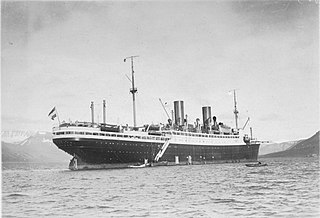
SS General von Steuben was a German passenger liner and later an armed transport ship of the German Navy that was sunk in the Baltic Sea during World War II. She was launched in 1923 as München, renamed General von Steuben in 1930, and renamed Steuben in 1938.

Robert Ley was a German politician during the Nazi era, who headed the German Labour Front from 1933 to 1945. He also held many other high positions in the German Nazi Party, including Gauleiter, Reichsleiter and Reichsorganisationsleiter. He committed suicide while awaiting trial at Nuremberg for crimes against humanity and war crimes.

NSGemeinschaftKraft durch Freude was a German NSDAP-operated leisure organization in Nazi Germany. It was part of the German Labour Front, the national labour organization at that time. Set up in November 1933 as a tool to promote the advantages of Nazism to the German people and internationally, while also being utilized to ease the process of the rearmament of Germany. It was also intended to compensate for the poor increases in wages and for the loss of trade union rights. Through its structure of organized events and promotion of propaganda, it was also intended to prevent dissident and anti-state behavior. By 1939, it had become the world's largest tourism operator.
The German Labour Front was the national labour organization of the Nazi Party, which replaced the various independent trade unions in Germany during the process of Gleichschaltung or Nazification.
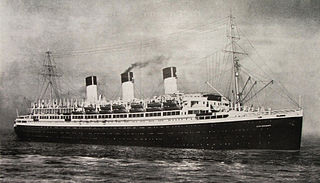
SS Cap Arcona, named after Cape Arkona on the island of Rügen, was a large German ocean liner, later a ship of the German Navy, and finally a prison ship. A flagship of the Hamburg Südamerikanische Dampfschifffahrts-Gesellschaft, she made her maiden voyage on 29 October 1927, carrying passengers and cargo between Germany and the east coast of South America, and for a brief period of time she was the largest and fastest ship on the route, until one month later she was surpassed on the same Europe-South America route by the Italian liner MS Augustus (1926).

Goya was a Norwegian motor freighter used as a troop transport by Nazi Germany and sunk with a massive loss of life near the end of World War II.

Imperator was a German ocean liner built for the Hamburg America Line, launched in 1912. At the time of her completion in June 1913, she was the largest passenger ship in the world by gross tonnage, surpassing the new White Star liner Olympic.

The Colossus of Prora, commonly known as simply "Prora", is a building complex in the municipality of Binz on the island of Rügen, Germany. It was built by Nazi Germany between 1936 and 1939 as part of the Strength Through Joy project. It consisted of eight identical buildings and was 4.5 km (2.8 mi) in length parallel to the beach, with the surviving structures stretching 3.0 km (1.9 mi).
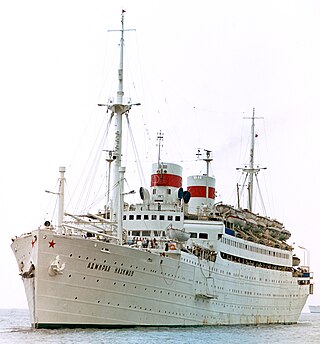
SS Admiral Nakhimov, launched in March 1925 and originally named SS Berlin, was a passenger liner of the German Weimar Republic later converted to a hospital ship, then a Soviet passenger ship. On 31 August 1986, Admiral Nakhimov collided with the large bulk carrier Pyotr Vasev in the Tsemes Bay, near the port of Novorossiysk, Russian SFSR, and quickly sank. In total, 423 of the 1,234 people on board died.
Julius Schulte-Frohlinde was one of Adolf Hitler's architects.

USS Zeppelin was a passenger liner launched in 1914 as SS Zeppelin by Bremer Vulkan, Bremen-Vegesack, Germany, for Norddeutscher Lloyd (NDL). Due to the First World War she never entered NDL service. She had a career after the war first under White Star Line control, then briefly as the troop ship USS Zeppelin, next as the Orient SN Co liner SS Ormuz and finally back with NDL as SS Dresden.

The Olympic-class ocean liners were a trio of British ocean liners built by the Harland & Wolff shipyard for the White Star Line during the early 20th century. They were Olympic (1911), Titanic (1912) and Britannic (1914). All three were designed to be the largest and most luxurious passenger ships at that time, designed to give White Star an advantage in the transatlantic passenger trade.

TS Maxim Gorkiy was, until 30 November 2008, a cruise ship owned by Sovcomflot, Russia, under long-term charter to Phoenix Reisen, Germany. She was built in 1969 by Howaldtswerke-Deutsche Werft, Hamburg, West Germany for the German Atlantic Line as TS Hamburg. In late 1973 she was very briefly renamed TS Hanseatic. The following year she was sold to the Black Sea Shipping Company, Soviet Union and received the name Maksim Gorkiy in honour of the writer Maxim Gorky, renamed to Maxim Gorkiy after the collapse of the Soviet Union in 1991. On 20 August 2008 Maxim Gorkiy was sold to Orient Lines. She was due to enter service with her new owners on 15 April 2009 under the name TS Marco Polo II, but in November 2008 the relaunch of the Orient Lines brand was cancelled. On 8 January 2009 the ship was sold for scrap, and she was beached at Alang, India on 26 February 2009.

Parliamentary elections were held in Germany on 10 April 1938. They were the final elections to the Reichstag during Nazi rule and took the form of a single-question referendum asking whether voters approved of a single list of Nazi and pro-Nazi guest candidates for the 814-member Reichstag, as well as the recent annexation of Austria. Turnout in the election was officially 99.6% with 99.1% voting 'yes' in Germany and Austria.

HMT Empire Windrush, originally MV Monte Rosa, was a passenger liner and cruise ship launched in Germany in 1930. She was owned and operated by the German shipping line Hamburg Süd in the 1930s under the name Monte Rosa. During World War II she was operated by the German navy as a troopship. At the end of the war, she was taken by the British Government as a prize of war and renamed the Empire Windrush. In British service, she continued to be used as a troopship until March 1954, when the vessel caught fire and sank in the Mediterranean Sea with the loss of four crewmen. HMT stands for "His Majesty's Transport" and MV for "Motor Vessel".

The Wolfsburg Volkswagen Factory is the worldwide headquarters of the Volkswagen Group, and one of the largest manufacturing plants in the world, in terms of area at just under 6.5 million m². The Wolfsburg plant produced 815,000 cars in 2015. Volkswagen's currywurst is also produced at this facility.

Vityaz is a research vessel that was built in 1939 by Deutsche Schiff- und Maschinenbau AG, Bremen, Germany as Mars for Neptun Line, Bremen. She served with the Kriegsmarine during World War II and was seized by the United Kingdom in 1945. She was renamed Empire Forth for the Ministry of War Transport (MoWT).

Darkness Fell on Gotenhafen is a 1960 German drama film directed by Frank Wisbar. It dramatizes the sinking of MV Wilhelm Gustloff, which was sunk while carrying German servicemen and around 6,000 civilian evacuees. Heinz Schön presents the combined death toll as 9,343.


















